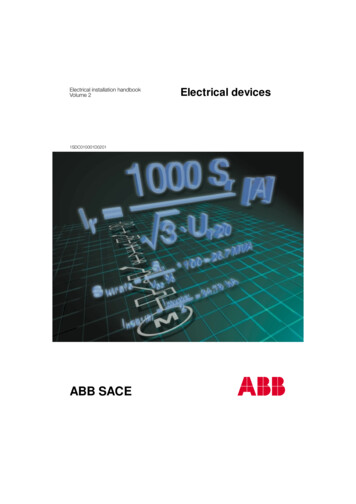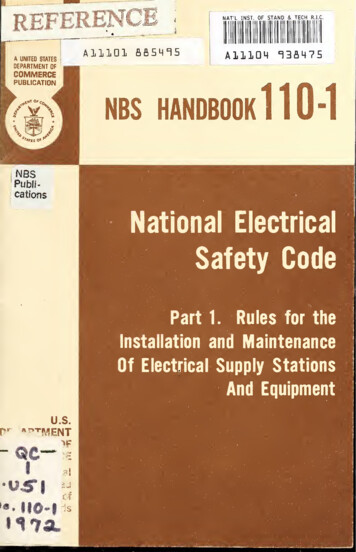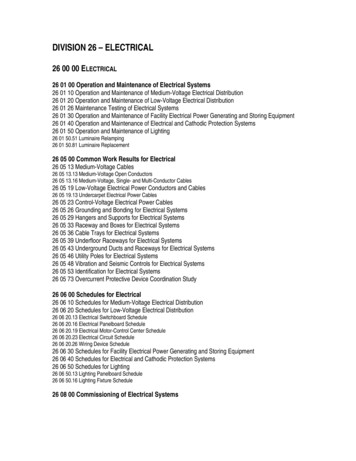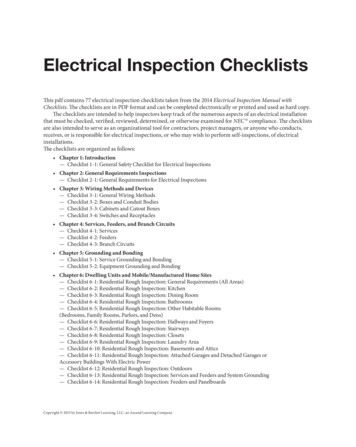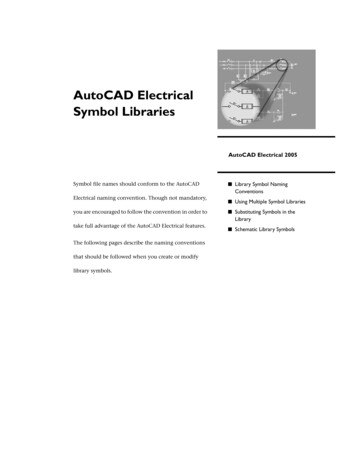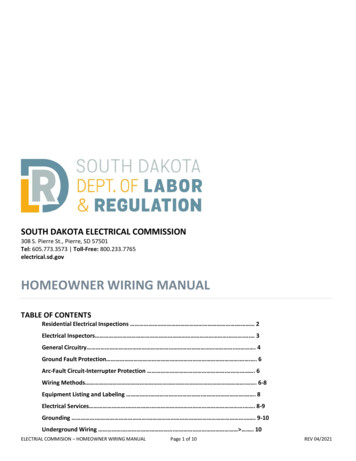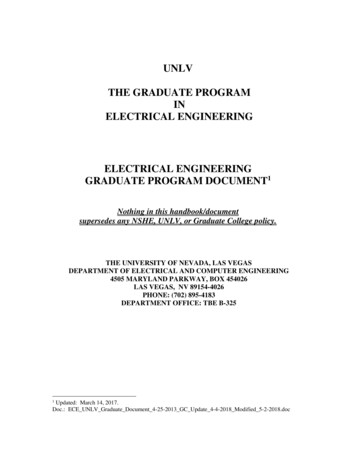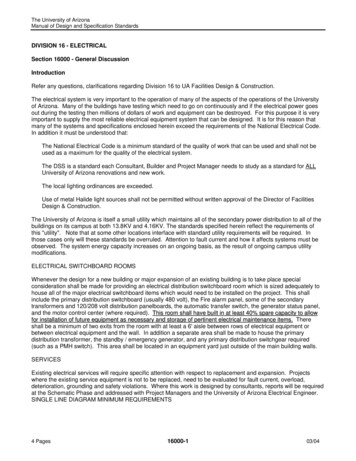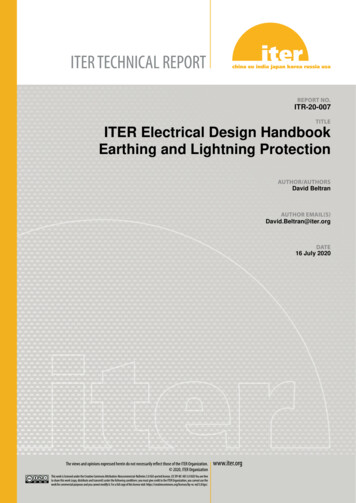
Transcription
ITR-20-007ITER Electrical Design HandbookEarthing and Lightning ProtectionDavid BeltranDavid.Beltran@iter.org16 July 2020
ITR-20-007ITER Electrical Design HandbookEarthing and Lightning ProtectionThis work is licensed under the Creative Commons Attribution-Noncommercial-NoDerivs 3.0 IGO-ported license. (CC BY-NC-ND 3.0 IGO)You are free to share this work (copy, distribute and transmit) under the following conditions: you must give credit to the ITER Organization,you cannot use the work for commercial purposes and you cannot modify it. For a full copy of this license d/3.0/igo/.
ITR-20-007 Introduction Terminology & Acronyms Earthing and Lightning Protection
ITR-20-007IntroductionAbstractThis manual is provided for the use of all Departments of the ITER Organization and is addressed to systemspecifiers, designers and users of electrical components in otherwise non-electrical plant systems.This is an initial version of this document that has been reviewed in accordance with the ITER MQP.Review comments have in part been addressed and others will be considered in detail and addressed at thenext revision.Introduction1
ITR-20-007Contents1Introduction . 31.1Standard Voltages . 51.1.1 Applicable IEC standards . 51.1.2 Low Voltage, single & 3 phase, 50Hz . 51.1.3 High Voltage, 3 phase, 50 Hz . 61.2Standard Test Voltages. 61.2.1 Applicable IEC standards . 61.3Voltage Classes . 71.4Insulation Coordination . 81.4.1 Applicable IEC standards . 81.5Standard Current Ratings . 81.5.1 Applicable IEC standards . 8List of TablesTable 1.1Table 1.2Table 1.3Table 1.4Table 1.5Table 1.6Table 1.7IntroductionIEC Definition of Voltage Levels 5Low Voltage (LV) used at ITER 5Medium Voltages (MV), Intermediate Voltage (IV) and High Voltage (HV) used at ITER 6Test Voltages 7Voltage Classes 7Insulation Withstand Voltages 8IEC Standard Current Ratings 92
ITR-20-0071 IntroductionThis document will be published in the Baseline documentation folder of the ITER Document Management(IDM) System and will be the subject of continual review and revision throughout the lifetime of the ITERproject.This handbook is provided for the use of all Departments of the ITER Organization and is addressed primarilyto system specifiers, designers and users of electrical components in otherwise non-electrical plant systems,rather than to designers of the power supply systems. The latter shall in addition comply with many otherstandards, instructions and industrial practices that are beyond the scope of this handbook.Standardisation GuidesAll electrical components and plant systems used or installed at ITER shall comply with the requirements set outin this EDH.In particular, voltage and current ratings must be selected for connection to the ITER standard nominal systemvoltages that have been selected from the IEC standards as given in the Section on Standard Voltages.The related test voltages are given in the Section on Standard Test Voltages.Introduction3
ITR-20-007Introduction4
ITR-20-0071.1 Standard Voltages1.1.1 Applicable IEC standardsIEC 60038IEC Standard VoltagesInternational Standard IEC 60038 defines a set of standard voltages for use in low voltageand high voltage AC electricity supply systems.The definition of voltage levels is as follows:IEC voltage rangeExtra-low voltageACDC 50 Vrms 120 Vdefining risklow riskLow voltage50–1000 Vrms 120–1500 V electrical shockHigh voltage 1000 VrmsTable 1.1 1500 V electrical arcingIEC Definition of Voltage Levels1.1.2 Low Voltage, single & 3 phase, 50HzThe 230V/400V level (in bold text) is that adopted for use by ITER:rms voltage between a phaseand the neutral connectorCorresponding rms voltagebetween two phases. Fourwire (with neutral) or threewire (without neutral) systems230 V400 V400V690V1000V-LVTable 1.2IntroductionLow Voltage (LV) used at ITER5
ITR-20-0071.1.3 High Voltage, 3 phase, 50 HzWhilst defined by IEC as being High Voltage, i.e. 1000 Vrms, the following voltage levels shall bereferred to within ITER as Medium Voltage (MV), i.e. 1 kV Vr 35 kV, Intermediate Voltage (IV),i.e. 35 kV Vr 230 kV or as High Voltage (HV), i.e. 230 kV Vr 800 kV.The levels in bold are those adopted for use by ITER:Highest voltage for equipment Nominal system voltage VmMVIVHVTable 1.3kV VrkV ( 220420400Medium Voltages (MV), Intermediate Voltage (IV) and High Voltage (HV) used at ITER1.2 Standard Test Voltages1.2.1 Applicable IEC standardsIEC 60060High-Voltage Test TechniquesInternational Standard IEC 60060 defines a set of tests on equipment having its highest voltage forequipment Vm above 1kV, i.e. in the case of components and plant systems used or installed at ITER, anythat are to be connected to a supply voltage higher than that classed as low voltage, must be subjected totesting.This standard is applicable to: dielectric tests with direct voltage; dielectric tests with alternating voltage; dielectric tests with impulse voltage;Vm represents the dielectric strength of an equipment, device or system for which it is designatedVr represents the nominal or rated system voltage at which an equipment, device or system shall usually operate Introduction6
ITR-20-007 tests with impulse current; tests with combinations of the above.Highest voltage forequipmentStandard short-duration power frequencywithstand voltageVm kVkV (rms Standard lightning impulsewithstand voltageIf values in brackets are considered insufficient to prove that the required phase-to-phasewithstand voltage are met, additional tests are needed.Table 1.4Test Voltages1.3 Voltage ClassesThe voltage class of a power circuit defines the degree of availability of the power delivery. The followingclassification of the power delivery circuits have been adopted at ITER:Class IUninterruptible DC (up to 250 V)DC battery supplies; batteries charging when ACsupply is available. AC supply may be Class III orClass IV depending on Safety LevelClass IIUninterruptible AC (230/400 V)Provided from UPS systems, will switch toalternate supply. Alternate AC supply may beClass III or Class IV depending on Safety LevelClass IIITemporarily interruptible AC(230/400 V and 6.6 kV)Provided from diesel motor generators,interruption for 30 s while generators start upClass IVIndefinitely interruptible AC(230/400 V and 6.6 kV).Directly provided from the electrical supplynetworkTable 1.5IntroductionVoltage Classes7
ITR-20-0071.4 Insulation Coordination1.4.1 Applicable IEC standardsIEC 60071IEC Insulation CoordinationThe following table shows standard insulation levels for range I (1kV Vm 245 kV)Highest voltage forequipment (Vm)Standard rated short- duration powerfrequency withstand voltageStandard rated lightning impulsewithstand voltagekV (rms value)kV (rms value)kV (peak 650)(325)(750)3608503959504601050245Note:170If values in brackets are considered insufficient to prove that the required phase-to-phasewithstand voltage are met, additional tests are needed.Table 1.6Insulation Withstand Voltages1.5 Standard Current Ratings1.5.1 Applicable IEC standardsIEC 60059IEC Standard Current RatingsThis standard specifies standard current ratings for electrical devices, apparatus, instruments andequipment and should be applied to the designing or utilisation of systems or equipment as well as tooperating characteristics. This standard does not apply to current ratings of components and parts usedwithin electrical devices or items of equipment.Introduction8
ITR-20-007Standard current ratings in amperes have been fixed by the IEC as 2500315040005000630080001000012500160002000025000 31500 40000 50000 63000 80000100000 125000 160000 200000Table 1.7IntroductionIEC Standard Current Ratings9
ITR-20-007Terminology & AcronymsAbstractThis part lists all terms, definitions and acronyms that may be referenced when specifying an electricalcomponent, device or system for use by the ITER Organization.This is an initial version of this document that has been reviewed in accordance with the ITER MQP. Reviewcomments have in part been addressed and others will be considered in detail and addressed at the next revision.Terminology & Acronyms1
ITR-20-007Contents1Terminology . 41.12Main Definitions from IEC Standards . 51.1.1 Nominal System Voltage . 51.1.2 Rated Voltage/Current of Equipment . 51.1.3 Highest System Voltage. 51.1.4 Highest Voltage for Equipment . 51.1.5 Insulation Coordination . 51.1.6 The Standard Short-Duration Power Frequency Voltage . 51.1.7 The Lightning Impulse Voltage . 5Common Definitions Adopted for ITER . 52.1.1 AC/DC Charger . 52.1.2 Batteries. 52.1.3 Busbar. 62.1.4 Bus Coupler . 62.1.5 Cable . 62.1.6 Cable Tray. 62.1.7 Circuit Breaker . 62.1.8 Converter . 62.1.9 Current Transformer . 62.1.10Diesel Generator . 62.1.11Disconnector . 62.1.12Earth Switch . 72.1.13Electrical Interlock . 72.1
IEC 60059 IEC Standard Current Ratings This standard specifie s standard current ratings for electrical devices, apparatus, instruments and equipment and should be applied to the designing or utilisation of systems or equipment as well as to

